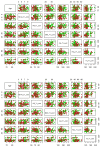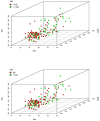Assessing the Risk of Hypertension in Chronic, Elderly Patients during the COVID-19 Pandemic: A Prospective Study
- PMID: 38248891
- PMCID: PMC10816727
- DOI: 10.3390/jcdd11010021
Assessing the Risk of Hypertension in Chronic, Elderly Patients during the COVID-19 Pandemic: A Prospective Study
Abstract
Background: This study considers care management for older chronic patients during and after the COVID-19 pandemic.
Aims: To identify groups of variables at previous time points as a basis for deriving efficient classification models during and after a pandemic situation and to quantify the effect of each variable within the model to predict levels of worsening risk in diastolic and systolic arterial hypertension (AHT).
Material and methods: In this prospective longitudinal study, data were collected at three time points: before, during, and after the COVID-19 pandemic period.
Results: The study included 148 patients with an average age of 81.6 years. During the study period, mean systolic blood pressure among this population rose by 5 mmHg to 128.8 mmHg; the number of patients with systolic blood pressure > 140 mmHg rose by 45.3%; among those with diastolic blood pressure > 90, the number rose by 41.2%; mean triglycerides levels rose to 152.6 mg/dL; cholesterol levels rose to 147 mg/dL; and LDL cholesterol rose to 112.2 mg/dL. Meanwhile, mean levels of HDL cholesterol decreased to 46.5 mg/dL. Binary-response logistic regression models were constructed to identify the most relevant variables for predicting AHT risk during and after the pandemic. The heart rate (OR = 1.79; 95% CI: 1.22-2.72) and body mass index (OR = 1.75; 95% CI: 1.08-2.94) variables were significant at the population level (p < 0.05) for diastolic and systolic AHT in the pandemic period risk models. The body mass index variable was also significant for diastolic AHT in the post-pandemic period risk model (OR = 1.97; 95% CI: 1.32-2.94), whilst the triglycerides variable was significant in the systolic AHT post-pandemic period risk model (OR = 1.49; 95% CI: 1.01-1.86).
Conclusions: Bad control of arterial hypertension in older patients with chronic disease is associated with elevated levels of LDL cholesterol, total cholesterol, systolic blood pressure, heart rate and triglycerides, and lower levels of HDL cholesterol.
Keywords: COVID-19 disease; SARS-CoV-2 infection; cardiovascular disease; hypercholesterolemia; hypertension; older.
Conflict of interest statement
The authors declare they have no conflicts of interest regarding this study.
Figures



Similar articles
-
Association of Lipid Levels With the Prevalence of Hypertension in Chinese Women: A Cross-Sectional Study Based on 32 Health Check Centers.Front Endocrinol (Lausanne). 2022 Jul 7;13:904237. doi: 10.3389/fendo.2022.904237. eCollection 2022. Front Endocrinol (Lausanne). 2022. PMID: 35873005 Free PMC article.
-
Outcomes of the Indonesian Chronic Disease Management Program (PROLANIS) in Patients with Hypertension During the COVID-19 Pandemic in Rural Areas: A Preliminary Evaluation Study.Med Sci Monit. 2023 May 12;29:e939797. doi: 10.12659/MSM.939797. Med Sci Monit. 2023. PMID: 37170483 Free PMC article.
-
Systolic and pulse blood pressures (but not diastolic blood pressure and serum cholesterol) are associated with alterations in carotid intima-media thickness in the moderately hypercholesterolaemic hypertensive patients of the Plaque Hypertension Lipid Lowering Italian Study. PHYLLIS study group.J Hypertens. 2001 Jan;19(1):79-88. doi: 10.1097/00004872-200101000-00011. J Hypertens. 2001. PMID: 11204308 Clinical Trial.
-
[Target values in hypertension treatment. Will they apply in older patients with hypertension, diabetics and in patients with IHD?].Vnitr Lek. 2009 Sep;55(9):833-40. Vnitr Lek. 2009. PMID: 19785385 Review. Czech.
-
Effects of low sodium diet versus high sodium diet on blood pressure, renin, aldosterone, catecholamines, cholesterol, and triglyceride.Cochrane Database Syst Rev. 2020 Dec 12;12(12):CD004022. doi: 10.1002/14651858.CD004022.pub5. Cochrane Database Syst Rev. 2020. PMID: 33314019 Free PMC article.
Cited by
-
Comparative Effects of Candesartan Versus Enalapril on Apelin, Visfatin, and Lipid Levels in Non-obese Hypertensive Patients.Medeni Med J. 2024 Sep 30;39(3):204-210. doi: 10.4274/MMJ.galenos.2024.16098. Medeni Med J. 2024. PMID: 39350559 Free PMC article.
References
-
- Mostaza J.M., Pintó X., Armario P., Masana L., Real J.T., Valdivielso P., Arrobas-Velilla T., Baeza-Trinidad R., Calmarza P., Cebollada J., et al. SEA 2022 Standards for Global Control of Cardiovascular Risk. Clin. Investig. Arterioscler. 2022;34:130–179. doi: 10.1016/j.arteri.2021.11.003. - DOI - PubMed
-
- Arnett D.K., Blumenthal R.S., Albert M.A., Buroker A.B., Goldberger Z.D., Hahn E.J., Himmelfarb C.D., Khera A., Lloyd-Jones D., McEvoy J.W., et al. 2019 ACC/AHA Guideline on the Primary Prevention of Cardiovascular Disease: A Report of the American College of Cardiology/American Heart Association Task Force on Clinical Practice Guidelines. Circulation. 2019;140:e596. doi: 10.1161/CIR.0000000000000678. - DOI - PMC - PubMed
-
- Gorostidi M., Gijón-Conde T., De la Sierra A., Rodilla E., Rubio E., Vinyoles E., Oliveras A., Santamaría R., Segura J., Molinero A., et al. Guía práctica sobre el diagnóstico y tratamiento de la hipertensión arterial en España, 2022. Sociedad Española de Hipertensión–Liga Española para la Lucha contra la Hipertensión Arterial (SEH-LELHA) Hipertens. Riesgo Vasc. 2022;39:174–194. doi: 10.1016/j.hipert.2022.09.002. - DOI - PubMed
-
- Quesada-Caballero M., Carmona-García A., Chami-Peña S., Albendín-García L., Membrive-Jiménez C., Romero-Béjar J.L., la Fuente G.A.C.-D. COVID-19 and the Use of Angiotensin II Receptor Blockers in Older Chronic Hypertensive Patients: Systematic Review and Meta-Analysis. Medicina. 2023;59:1200. doi: 10.3390/medicina59071200. - DOI - PMC - PubMed
-
- Yang Y.-S., Pei Y.-H., Gu Y.-Y., Zhu J.-F., Yu P., Chen X.-H. Association between short-term exposure to ambient air pollution and heart failure: An updated systematic review and meta-analysis of more than 7 million participants. Front. Public Health. 2023;10:948765. doi: 10.3389/fpubh.2022.948765. - DOI - PMC - PubMed
LinkOut - more resources
Full Text Sources
Research Materials
Miscellaneous

